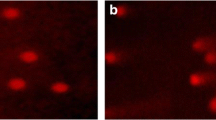Abstract
We conducted a case–control study to assess whether general DNA damage levels evaluated by comet assay (length of tail comet, tail extent moment, and olive tail moment) differ in Mexican patients with type 2 diabetes mellitus (DM2). The sample included 71 Mexican patients with DM2 who had developed the disease >5 years previously and had been treated with oral hypoglycemic drugs (sulfonylurea and/or metformin), with no microvascular or macrovascular complications. These patients were classified into three groups according to age: (I) 40–50 years, (II) 51–60 years, and (III) 61–70 years. A control group of 14 individuals (40–50 years) without DM2 was included. Our results showed there was a slight but not significant increase in DNA damage in the two groups of patients with DM2 aged between 40 and 60 years compared with the 61–70-year-old patient group and controls. In conclusion, given that general DNA damage was similar in the three groups of patients with DM2 and the control group, it is possible that these cells showed similar oxidative damage, as has been proposed previously.
Similar content being viewed by others
References
Baquera S, Tovar-Guzman V, Campos-Nonato I, Gonzalez-Villalpando C, Rivera-Dommarco J (2003) Geography of diabetes mellitus mortality in Mexico: an epidemiologic transition analysis. Arch Med Res 34:407–414
Wolff SP (1993) Diabetes mellitus and free radicals. Free radicals, transition metals and oxidative stress in the aetiology of diabetes mellitus and complications. Br Med Bull 49:642–652
Baynes JW (1991) Role of oxidative stress in development of complications in diabetes. Diabetes 40:405–412
Dandona P, Thusu K, Cook S, Snyder B, Makowski J, Armstrong D, Nicotera T (1996) Oxidative damage to DNA in diabetes mellitus. Lancet 347:444–445
Lafleur MV, Retel J (1993) Contrasting effects of SH-compounds on oxidative DNA damage: repair and increase of damage. Mutat Res 295:1–10
Yfjord JE, Bodvarsdottir SK (2005) Genomic instability and cancer: networks involved in response to DNA damage. Mutat Res 592:18–28
Khan A, Lasker SS, Chowdhury TA (2003) Are spouses of patients with type 2 diabetes at increased risk of developing diabetes? Diabetes Care 26:710–712
Gracy RW, Talent JM, Kong Y, Conrad CC (1999) Reactive oxygen species: the unavoidable environmental insult? Mutat Res 428:17–22
Pan HZ, Chang D, Feng LG et al (2007) Oxidative damage to DNA and its relationship with diabetic complications. Biomed Environ Sci 20:160–163
Colak E, Majkić-Singh N, Stanković S et al (2005) Parameters of antioxidative defense in type 2 diabetic patients with cardiovascular complications. Ann Med 37:613–620
Pitozzi V, Giovannelli L, Bardini G, Rotella CM, Dolara P (2003) Oxidative DNA damage in peripheral blood cells in type 2 diabetes mellitus: higher vulnerability of polymorphonuclear leukocytes. Mutat Res 529:129–133
Choi SW, Benzie IF, Lam CS et al (2005) Strain, Inter-relationships between DNA damage, ascorbic acid and glycaemic control in Type 2 diabetes mellitus. Diabetic Med 22:1347–1353
Blasiak J, Arabski M, Krupa R et al (2004) DNA damage and repair in type 2 diabetes mellitus. Mutat Res 554:297–304
Anderson D, Yutw S, Wright J, Loanides C (1998) An examination of DNA strand breakage in the comet assay and antioxidant capacity in diabetic patients. Mutat Res 398:151–161
Hannon-Fletcher MPA, O′Kane MJ, Moles KW et al (2000) Levels of peripheral blood cell DNA damage in insulin dependent diabetes mellitus human subjects. Mutat Res 460:58–60
Lodovici M, Caldini S, Luceri C, Bambi F, Boddi V, Dolara P (2005) Active and passive smoking and lifestyle determinants of 8-oxo-7,8-dihydro-2′-deoxyguanosine levels in human leukocyte DNA. Cancer Epidemiol Biomark Prev 14:2975–2977
Latin-American Association of Diabetes for the diagnosis and management of the type 2 Diabetes Mellitus with medicine based on evidence (2000) extraordinary edition, pp 1–64. http://www.alad.org/does.htlm.2003
Pool-Zobel BL, Guigas C, Klein R, Neudecker C, Renner HW, Schmezer P (1993) Assessment of genotoxic effects by lindane. Food Chem Toxicol 312:71–83
Singh NP, McCoy MT, Tice RR, Schneider EL (1988) A simple technique for quantitation of low levels of DNA damage in individual cells. Exp Cell Res 175:184–191
Collins A, Dusinská M, Franklin M, Somorovská M, Petrovská H, Duthie S, Fillion L, Panayiotidis M, Raslová K, Vaughan N (1997) Comet assay in human biomonitoring studies: reliability, validation, and applications. Environ Mol Mutagen 30:139–146
Lodovici M, Giovannelli L, Pitozzi V, Bigagli E, Bardini G, Rotella CM (2008) Oxidative DNA damage and plasma antioxidant capacity in type 2 diabetic patients with good and poor glycaemic control. Mutat Res 638:98–102
Fenech M (1999) Micronucleus frequency in human lymphocytes is related to plasma vitamin B12 and homocysteine. Mutat Res 428:299–304
Tompa A, Major J, Jakab MG (1994) Monitoring of benzene-exposed workers for genotoxic effects of benzene: improved-working-condition-related decrease in the frequencies of chromosomal aberrations in peripheral blood lymphocytes. Mutat Res 304:159–165
Anderson D, Hughes JA, Cebulska-Wasilewska A, Wierzewska A, Kasper E (1996) Biological monitoring of workers exposed to emissions from petroleum plants. Environ Health Perspect 104(Suppl 3):609–613
Tyrberg B, Anachkov KA, Dib SA, Wang-Rodriguez J, Yoon KH, Levine F (2002) Islet expression of the DNA repair enzyme 8-oxoguanosine DNA glycosylase (Ogg1) in human type 2 diabetes. BMC Endocr Disord 2:2
Author information
Authors and Affiliations
Corresponding author
Rights and permissions
About this article
Cite this article
Ibarra-Costilla, E., Cerda-Flores, R.M., Dávila-Rodríguez, M.I. et al. DNA damage evaluated by comet assay in Mexican patients with type 2 diabetes mellitus. Acta Diabetol 47 (Suppl 1), 111–116 (2010). https://doi.org/10.1007/s00592-009-0149-9
Received:
Accepted:
Published:
Issue Date:
DOI: https://doi.org/10.1007/s00592-009-0149-9




